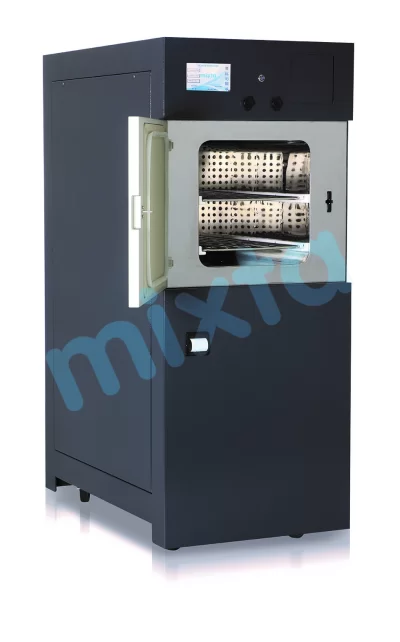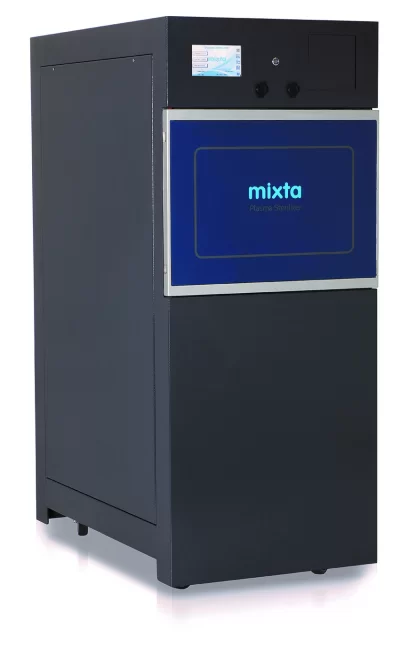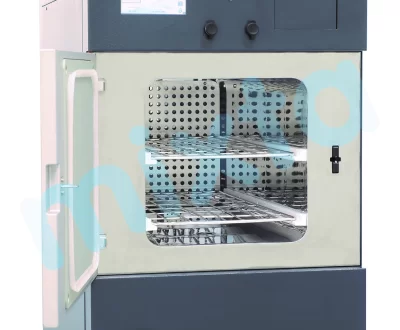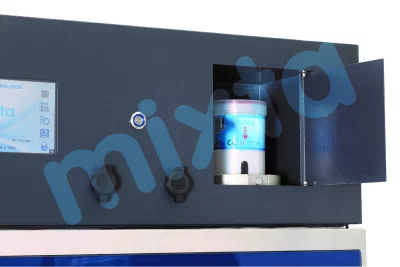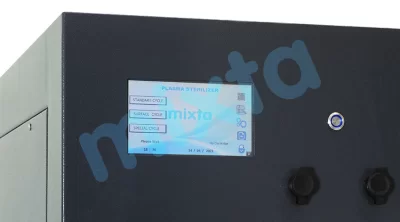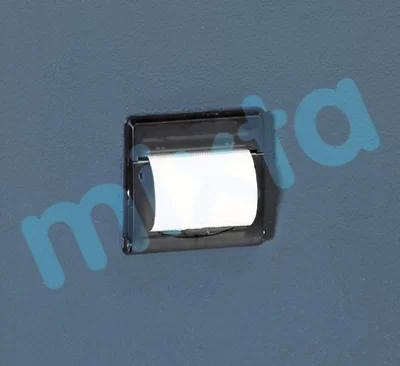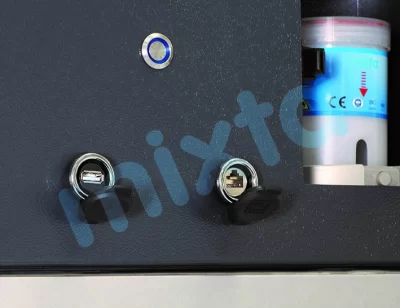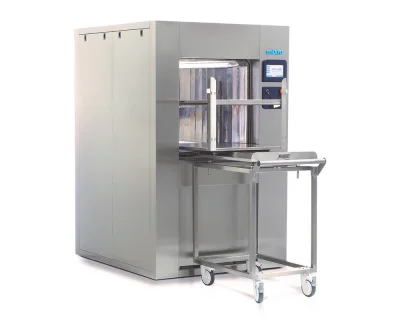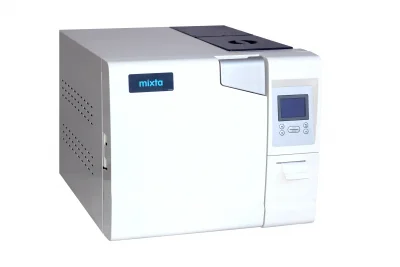Plasma Sterilizers
- Fast Heating & Drying System
- Microprocessor PLC with 7" Color Touch LCD
- Monitoring System 200 Cycles RS 232
- Port / USB, Ethernet 20 Cycles / Hydrogen Peroxide
- Cartridge Cycle Durations:
- FAST 25+5 Minutes
- STANDARD 30+5 Minutes
- LONG 45+5 Minutes
- Cycle Temperature 50+5 °C
- Emergency Stop, Multiple language options, RFID Coding
A plasma sterilizer has been developed with the aim of sterilizing materials and equipment through the utilization of low-temperature hydrogen peroxide gas plasma technology. Hydrogen peroxide plasma sterilizer's primary objective is to ensure effective sterilization while preserving the integrity of heat-sensitive items. These Low-temperature sterilizers are advantageous because they offer rapid sterilization cycles, compatibility with various materials, absence of toxic residue, an easy-to-use interface, and compliance with regulatory standards. These features make Hydrogen peroxide sterilizer a reliable and efficient solution for achieving comprehensive sterilization while minimizing the risk of damage to delicate instruments or devices.
Mixta takes into account parameters such as the number and type of instruments, expected workload, available space, desired cycle time, instrument compatibility, specialized configurations, and regulatory compliance when determining the capacity and configurations of a plasma H202 Sterilizer. We offer ''plug and play'' machine and options with single-door or double-door configurations and various capacities ranging as 100 L, 120 L and 150 L to meet specific needs.
The selection and procurement of a Low Temperature Plasma Sterilizer holds great significance for healthcare facilities. As Mixta, we understand the importance of ensuring patient safety, compliance, and productivity within a busy Sterile Processing Department (SPD). When healthcare facilities embark on the journey of purchasing a Plasma sterilization technology, they carefully evaluate various factors such as the reputation of the brand, the level of service support provided, cost considerations, and the environmental impact of the equipment. Given the critical role that plasma sterilization plays in hospitals, and other healthcare facilities, buyers typically conduct thorough research, exploring multiple options before making their final decision. Throughout this buying process, our dedicated sales representatives are readily available to guide and assist healthcare professionals in selecting the most suitable plasma sterilizer for their specific needs.
Plasma Sterilizers: The Future of Medical Sterilization
Sterilization is a critical component in healthcare, ensuring that medical instruments are free of harmful microorganisms. Plasma sterilizers have revolutionized this field, providing an efficient, eco-friendly alternative to traditional methods like steam sterilization. Utilizing low-temperature plasma technology, these sterilizers offer a safe and reliable way to sterilize a wide range of medical instruments, particularly those sensitive to heat and moisture.
What is Plasma Sterilization?
Plasma sterilization is a process that uses hydrogen peroxide vapor combined with plasma, an ionized gas, to eliminate microorganisms from medical devices. The vapor creates reactive species that break down microbial cells, effectively killing bacteria, viruses, and fungi. This process operates at low temperatures, making it ideal for heat-sensitive medical instruments that cannot withstand the high temperatures used in autoclaves.
Key Features of Plasma Sterilizers
1. Low-Temperature Sterilization
Traditional sterilization methods, like steam, require high temperatures, which can damage delicate instruments. Plasma sterilizers operate at much lower temperatures, typically between 40°C and 60°C, ensuring that sensitive devices remain intact and functional post-sterilization.
2. Fast Sterilization Cycles
Plasma sterilizers are designed to perform rapid sterilization cycles, with most units completing a full sterilization cycle in under an hour. This quick turnaround is crucial for busy healthcare settings, where equipment needs to be readily available for procedures.
3. Environmentally Friendly
One of the most significant advantages of plasma sterilizers is their minimal environmental impact. The sterilization process breaks down the hydrogen peroxide into harmless by-products, primarily water and oxygen, which means no toxic waste or chemical residues are left behind.
4. Safe for a Wide Range of Materials
Plasma sterilization is suitable for a variety of materials, including plastics, metals, and rubber. This versatility allows healthcare providers to sterilize everything from surgical instruments to endoscopes, without worrying about damaging the equipment.
Why Choose Plasma Sterilizers?
1. Superior Safety and Efficacy
Plasma sterilizers offer exceptional efficacy against a wide range of pathogens, including bacteria, viruses, spores, and fungi. Their ability to sterilize at low temperatures while ensuring complete microbial elimination makes them a superior choice for sterilizing complex medical devices.
2. Ideal for Heat-Sensitive Devices
Medical devices made from delicate materials, such as electronics or optical instruments, require low-temperature sterilization to avoid damage. Plasma sterilizers provide the ideal solution, ensuring that these devices are thoroughly sterilized without any risk of heat-related degradation.
3. Cost-Effective in the Long Run
Although the initial investment in plasma sterilization technology can be higher than traditional sterilizers, the long-term benefits outweigh the costs. The rapid cycle times, minimal maintenance, and reduced energy consumption make plasma sterilizers a cost-effective option for healthcare facilities looking to improve sterilization processes.
Applications of Plasma Sterilization in Healthcare
Hospitals and Surgical Centers
Plasma sterilizers are widely used in hospitals and surgical centers where the demand for sterilized equipment is high. The ability to sterilize a broad range of medical instruments, including those sensitive to heat and moisture, makes these sterilizers invaluable in ensuring a smooth workflow and patient safety.
Dental Clinics
Dental instruments, particularly those with intricate designs, are prone to contamination. Plasma sterilizers provide a quick and effective way to ensure these tools are sterile and safe for use between patients.
Outpatient Facilities
For outpatient settings that perform minor surgical procedures, plasma sterilizers are a perfect solution for ensuring the safety and sterility of medical tools. Their compact size and quick cycle times make them well-suited for facilities that need rapid sterilization.








